|
|
Post by mybighair on Apr 27, 2010 15:31:35 GMT -5
I thought I was lucky this year when my tree collard started flowering, the person I received the cuttings from did say it flowered every year but most reports say flowering is rare. Then this evening, while looking at one of the Daubenton plants I received from Frank (orflo) that was growing particularly vigorously, I spotted flower buds. They are small by brassica standards but they are definitely flower buds.
I had to go back three times and check, just to be sure I wast seeing things, and I still half think I'm dreaming. I just cant believe my luck.
Whether these flowers produce viable pollen or seed remains to be seen. I've tried a few crosses to the tree collard already but they don't look to have taken, so it may not be easy. But I may actually have the opportunity to cross Daubenton with the tree collard and develop a viable seed propagated perennial population. If I'm really luck it could combine the bush habit of Daubenton with the larger leaves of the collard.
I do wish I had some red biannual kales coming into flower to try crossing to them, but I'm growing out a cross between Black Tuscany and variegated collards for seed production, so I pulled the rest of the kales early this year. Still, at least I have an interesting F1 hybrid to try crossing with this perennial material.
Hopefully things will work out with one of the crosses and I'll have some seed to play with. I'll try to get some pictures of the plants tomorrow, assuming this isn't all a dream.
All the best,
Dumbfound.
|
|
|
|
Post by raymondo on Apr 27, 2010 16:40:35 GMT -5
Excellent. Fingers crossed for you that a cross or two takes. What about bud pollinating the Daubenton with its own pollen, assuming there is any pollen?
|
|
|
|
Post by ottawagardener on Apr 27, 2010 17:27:49 GMT -5
Awe-some. I look forward to all reports. Looking forward to pictures.
|
|
|
|
Post by mybighair on Apr 28, 2010 3:38:20 GMT -5
raymondo, I did consider bud pollination to self the Daubenton flowers but I'm not sure I would get anything that different from Daubenton itself, so I'm going to prioritize the other crosses in the hope of producing something new. I managed to get some photos this morning, just before the rain started. The light was a bit low, but I did get a nice shot of the Daubenton flower buds. And I'll try to keep you all updated with further pictures as things progress. Not the best of shots, but it gives an Idea of the collards size 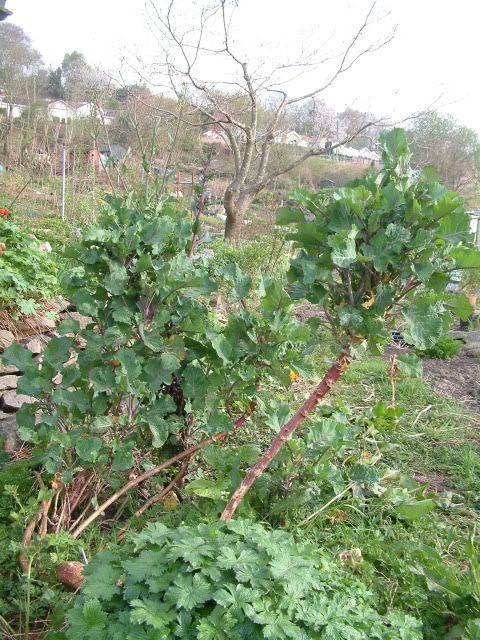 Not the best picture again but you can just about see the flowers I've attempted to pollinate so far. 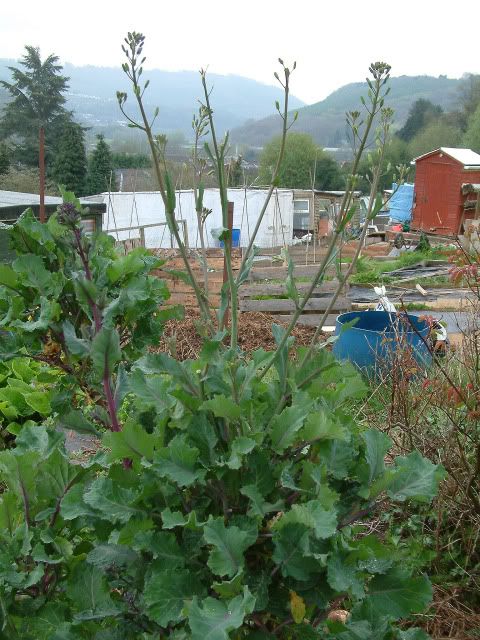 One or two of the most recent ones look like they may have taken so perhaps there's hope (not that you could tell from the photo). The next is just a quick shot of the F1 plants I'm using in these crosses.  They look a bit rough after the Wood Pigeons ravaged them during winter, but they were quite pretty plants before the attack. This is the Daubenton plant with the flower buds. 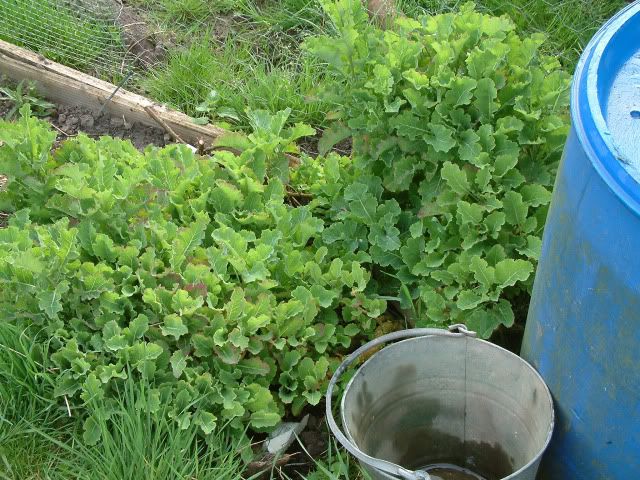 As you can see, it's shoved in next to the chicken run and the barrel I use to make comfrey liquid feed. None of my other Daubenton plants are showing signs of flower production, and it occurred to me that the positioning of this plant may explain it's flowering. I put the comfrey in a hessian sack before putting it into the barrel, it makes it easier to get the fermented comfrey out of the water so it doesn't clog up the watering can rose. I pulled this sack out over the top of the plant that's now flowering, drenching it in the undiluted feed. I also dumped the sack at the base of the plant to rot. So perhaps all that potash from the comfrey induced flowering. I'll try heavy watering with the undiluted feed on some of the other plants through this winter and into next spring to see if I can get them to flower to. And now the really interesting photo, the Daubenton flower buds. 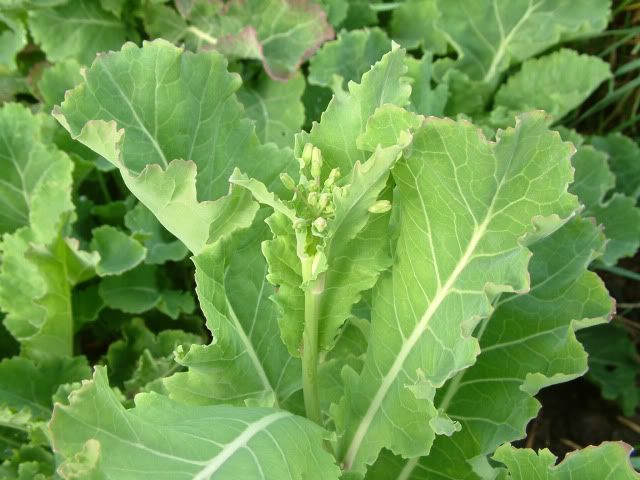 I just hope I can get seed from this plant, I really don't want to waste this opportunity. |
|
|
|
Post by ottawagardener on Apr 28, 2010 7:24:35 GMT -5
That's just way too neat. I look forward to hearing about seeds and baby kales.
|
|
|
|
Post by cortona on Apr 28, 2010 17:52:34 GMT -5
i have al the fingers crossed for you!
ah...compliments for the cross lacinatoxvariegato i grow the first one and i like it a lot
|
|
|
|
Post by ianpearson on Apr 29, 2010 10:37:49 GMT -5
Mybighair, I'm no brassica breeding expert, so ignore me if you think this would be a waste of time, but you said you would like a red kale in flower. I think I have a couple of Red Ursa coming into flower. When your time is right, if my time is right, I could send the flower heads by our entrusted Royal Mail. Would that work? or does pollen not survive long enough.
|
|
|
|
Post by orflo on Apr 30, 2010 0:34:39 GMT -5
Graham, this is very interesting, I have some flower buds on this tree collard you send me as well. But, what seems to be strange: I did send you the variegated-leaf Daubenton, but, when I look at your pictures, the variegated leaves seems to have disappeared, and they turned into a plain green variety. Or do I get a wrong impression? Here's a picture of my variegated Daubenton: 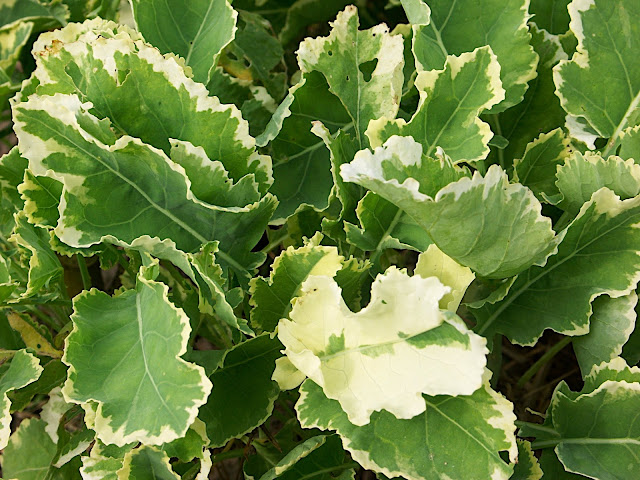 Sometimes though a new shoot, non-variegated, appears on the base of the variegated Daubenton version. I once had flowers on my 'Ehwiger Kohl' or 'Eeuwig moes' , and I tried pollinating them with some savoy cabbage, which was the only other cabbage flowering at that time in my garden. This pollination didn't work however, for some strange reason. The pollen was quite abundant, so that couldn't have been the reason. |
|
|
|
Post by mybighair on Apr 30, 2010 2:37:48 GMT -5
I quit agree Telsing, it's way too neat, I still cant quite believe it. Some of the cuttings I sent you may have come from this plant so keep your eyes pealed for signs of flowering.
cortona,
Black Tuscany is one of my favourites to, I actually made the cross to develop a broader leafed form with variegation. Surprisingly the Black Tuscany X variegated collards seedlings gave me exactly what I was looking for in the F1. They taste like B.T. and have the dark green, white variegated broad leaves. This would suggest that the genes I want are all fairly dominant, but is likely to make stabilising the line more difficult.
Ian,
Red Ursa could be an interesting one to try, both for its colouring and it's being a napus kale. I'm not sure how long lived brassica pollen is, and using napus pollen may affect the fertility of the F1 due to uneven chromosome numbers, but I'd like to give it a try. I'm hoping the pollen will have some longevity, as I'd like to try freezing some for use next season. I don't expect to see Daubenton in flower again and would like to try it with a few of the other kales I'm growing this year.
orflo,
Sorry for the confusion, this isn't the variegated form of Daubenton, I just forgot that it didn't come from you. It's one of the plants I bought from a French company. As I'm sure you're aware, there has been some research done on flowering in these vegetatively propagated perennial kale, and while they do flower in some years, they don't always produce seed. They probably require very specific conditions to achieve a successfully flowering cycle. I'll just have to hope my climate can produce those conditions this year.
I'll be trying pollination both ways with these plant to increase my chances of success, but I'd prefer to get seed from Daubenton to preserve its cytoplasmic DNA in future generations, just in case it plays a part in this type of perenniality.
|
|
|
|
Post by ottawagardener on Apr 30, 2010 16:11:24 GMT -5
Ha! As soon as you said they had flowers, I went out to see if just *if* mabye mine did too but no. I'll keep my eyes peeled though. Speaking of which, this kale has grown wonderfully since you sent it to me. The other two have as well but this one has gone from a cutting to a very sizeable plant in one year. I'm impressed.
|
|
|
|
Post by mybighair on May 9, 2010 16:21:02 GMT -5
Just a quick update. I look to have some successful pollinations on the tree collard with the pollen from my F1 cross. I have about 9 seed pods ripening at the moment. I've also collected and frozen some pollen for an attempt to cross it with broccoli later this season. A quick pick of some of the style becoming seed pods. 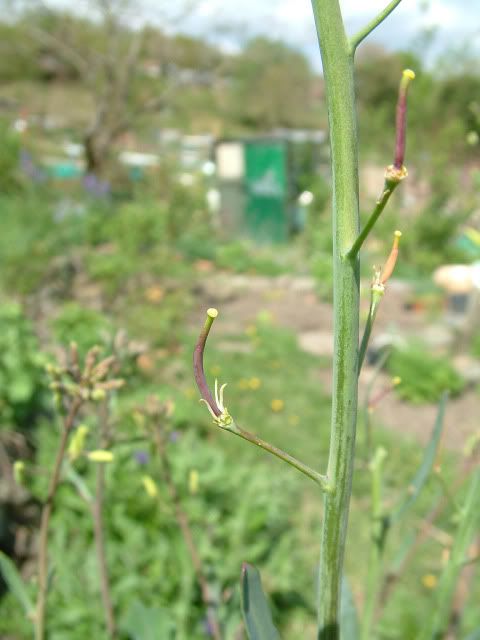 And the Daubenton flowers are coming along nicely. 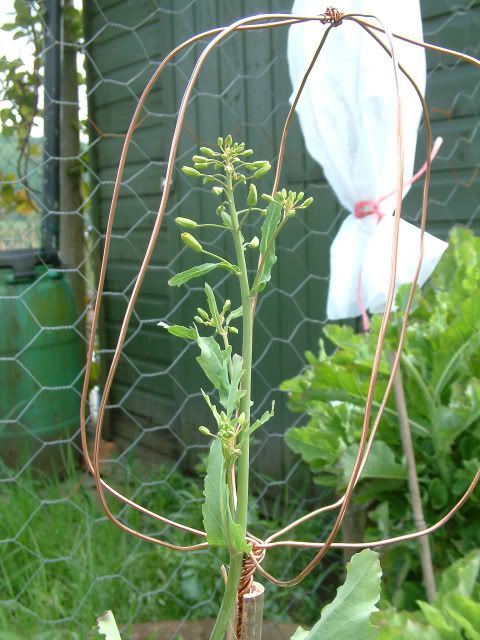 I've made some bloom protectors so I can allow the flowers to open fully before pollination. I want to collect as much pollen as possible and freeze it for next season and they should prevent unwanted pollinations by insects. I suspect the first of the flowers will open in the next few days so I should have some idea about fertility by the end of next week. For now I'm just enjoying thinking of all the possibilities before the limitations of reality spoil my fun. |
|
|
|
Post by ottawagardener on May 10, 2010 6:43:22 GMT -5
Very nice. I like your protector. Looking forward to hearing about your limitations and possibilities.
|
|
|
|
Post by trixtrax on May 11, 2010 0:16:21 GMT -5
Excellent Graham! Wow, I can only imagine the possibilities...
On a slightly related note, has any tried Primo? Not only was it a nice OP maturing cabbage with uniform tight heads, some of the plants seemed to have good advantageous rooting along the stem. I have seen it here and there on random plants of various B. oleracea, Does anyone also know of any kales, collards, cabbages, etc that root really well along the base or regrow from the roots? Rutabaga's seem to do this well. If a well advantageous rooting var was crossed with these seeds, imagine a mat forming, bushy collards.
Or, imagine crossing it with a kohlrabi or rutabaga, something interesting might result.
Look forward to following posts.
|
|
|
|
Post by raymondo on May 11, 2010 1:28:48 GMT -5
I put a lot of brassica scraps, including bits of root and lower stem, into the compost. They grow new plants, even the stem bits. I haven't taken them out and replanted them to see what happens but my guess is that if it's the right time of year, you'll get another whatever it was. Or perhaps all they'll do is run to seed. Hmm...now you have me curious. Some experimentation is in order. A nice little project, thanks.
|
|
|
|
Post by ottawagardener on May 11, 2010 8:23:10 GMT -5
Sprouting from roots or low internodes along the stem seems fairly common but I have been remiss about seeing if plants will root along the stem. Did you see ExtremeGardener's comment on the overwintering brassica thread?
Raymondo: Sounds like a fun experimental bandwagon. I am going to see if I can get some rooting going on. I've heard that it is fairly easy to root brassica stem cutting but haven't really tried it.
|
|